線上客服
客服團隊
剛剛
親愛的 LBank 用戶
我們的線上客服系統目前遇到連線故障。我們正積極修復這一問題,但暫時無法提供確切的恢復時間。對於由此給您帶來的不便,我們深表歉意。
如需幫助,您可以透過電子郵件聯繫我們,我們將盡快回覆。
感謝您的理解與耐心。
LBank 客服團隊
So you’ve gotten your toes wet in crypto. You know the basics of Bitcoin, you’ve seen the swing of the market from euphoria to panic and vice versa and you’ve even probably attempted buying a few coins at an exchange. But then you find yourself asking the inevitable question you end up asking yourself:
“Where do you keep it all?”
That’s not a technical point. It’s the basics of ownership in crypto. Because unlike your bank account, you can’t click “forgot password” in crypto in the event you get locked out. Whoever controls your keys controls the money.
A cryptocurrency wallet doesn’t store coins at all, it stores the private keys. And the keys unlock the stored balance residing on the blockchain. That gets us down to two major differences:
If that sounds a bit overwhelming, don’t worry, we’ll break it down step by step. At the end of it, you won’t just know about wallets, you’ll also know how to create a secure storage system in 2025.
Custodial wallets are like virtual banks. You log in by email and password and the exchange stores your crypto on their system.
Pros:
Cons:
Think about putting money into a bank. The bank displays the balance but they really possess the money. Same with custodial wallets you’re putting your trust in the middleman.
You are the sole key holder with non-custodial wallets. There is no company in between you and your money. The more popular examples include MetaMask, Trust Wallet, and Ledger hardware wallets.
Pros:
Cons:
Real life application: It’s like holding physical cash in your safe. No one can access it but in case you lose the safe’s key, it's gone.
Rule of thumb: Custodial wallets = convenient. Non-custoidal wallets = true ownership
Hot Wallets are never offline and are ideal to be used to carry out frequent transactions. There are apps like Phantom, Trust Wallet, and MetaMask in this group.
Think of hot wallets like a checking account for spending money, not for savings.
Cold wallets store your keys offline. The most widely known type are the hardware wallets (like ledger and Trezor), which access the internet only by physically plugging them in.
Cold storage is like your safe deposit box or savings account long term storage.
| Feature | MetaMask (Hot) | Trust Wallet (Hot) | Ledger Nano X (Cold) | Trezor Model T (Cold) |
| Type | Non-Custodial | Non-Custodial | Non-Custodial | Non-Custodial |
| Connectivity | Online (browser/app) | Online (mobile app) | Offline (USB/Bluetooth) | Offline (USB) |
| Best for | Ethereum & dApps | Multichain assets (70+ networks) | High security long term storage | Transparency & open source design |
| Key Differentiator | Ecosystem gateway for NFTs & DeFi | Wide multichain support | Bank grade Secure Element chip |
Fully open source code |
| Main Risks | Hacks and phishing | Hacks and phishing | Physical loss/damage | Physical loss/damage |
Pro Tip: if holding crypto long term, an ideal combination is a hot wallet to facilitate day to day usage and a cold storage to be on the safe side.
Crypto’s biggest risk is neither the technology nor the sentiment but it’s you. The vast majority of hacks are a result of user error.
Here is your non negotiable checklist:
Here’s a basic framework:
The majority of the smart users settle for the “hybrid approach”.
The end of the day decision is then one of control versus convenience.
The smartest move? Make use of a combination leaving tiny amounts in a hot wallet to spend and on dApps. Roll long term assets into a cold wallet .and never ever forget the one golden rule of owning a crypto assets:
“Not your keys, not your crypto.”
Disclaimer: The content created by LBank Creators represents their personal perspectives. LBank does not endorse any content on this page. Readers should do their own research before taking any actions related to the company and carry full responsibility for their decisions, nor can this article be considered as investment advice.




剛剛
親愛的 LBank 用戶
我們的線上客服系統目前遇到連線故障。我們正積極修復這一問題,但暫時無法提供確切的恢復時間。對於由此給您帶來的不便,我們深表歉意。
如需幫助,您可以透過電子郵件聯繫我們,我們將盡快回覆。
感謝您的理解與耐心。
LBank 客服團隊